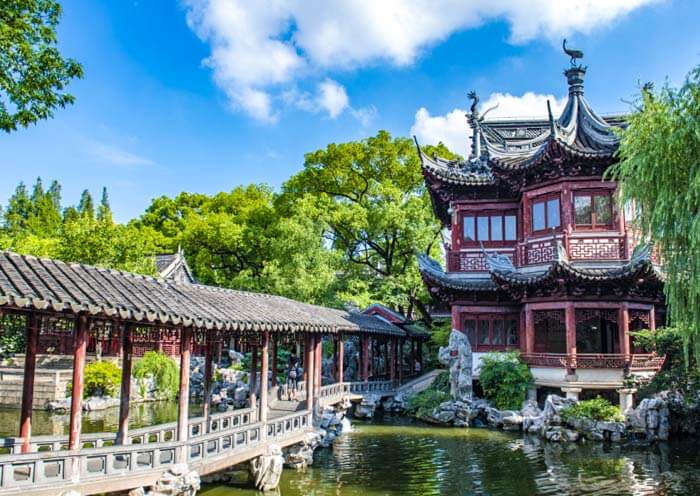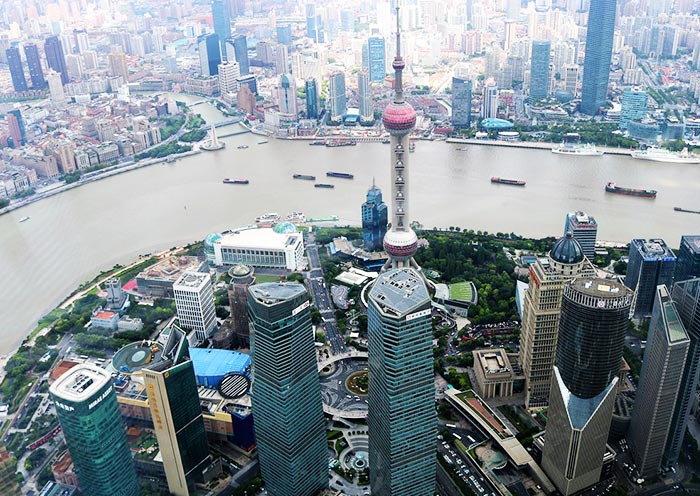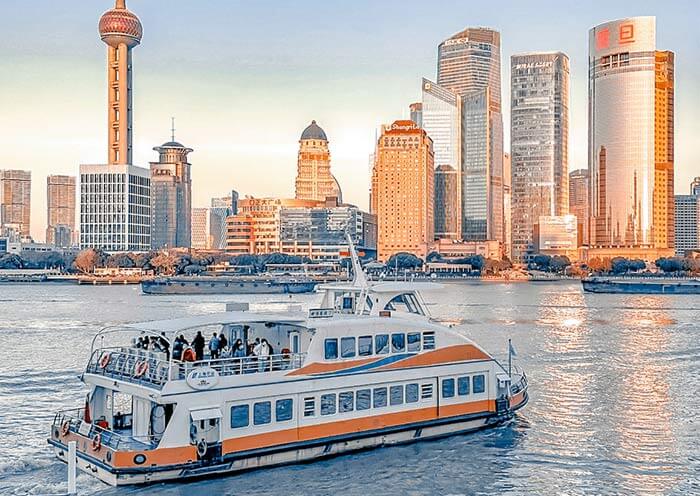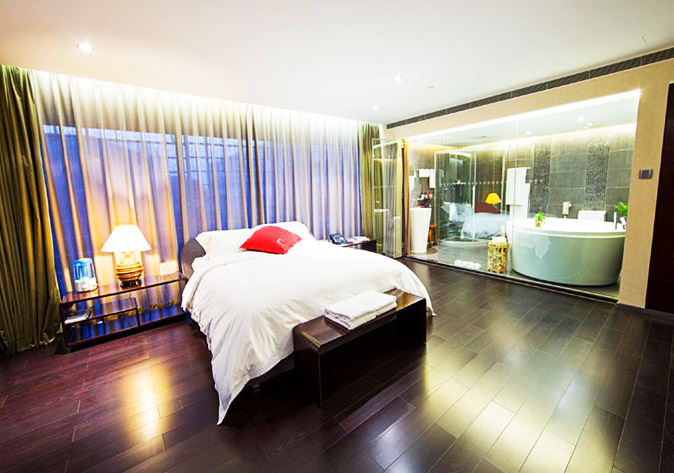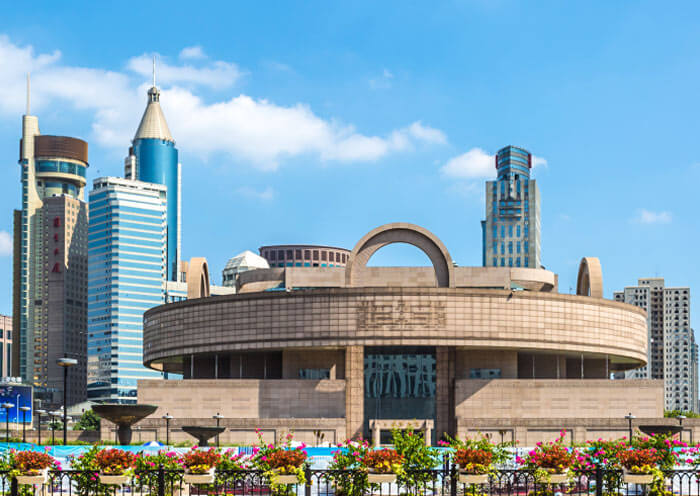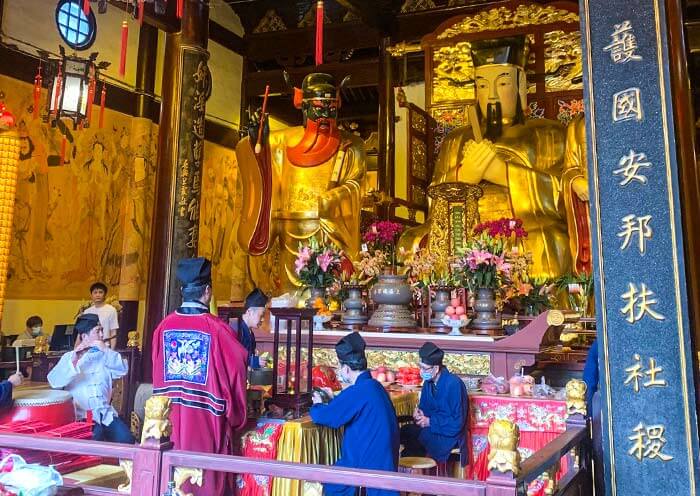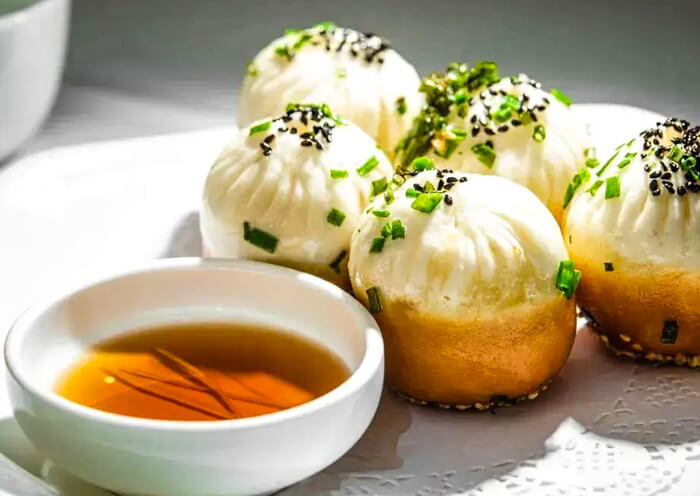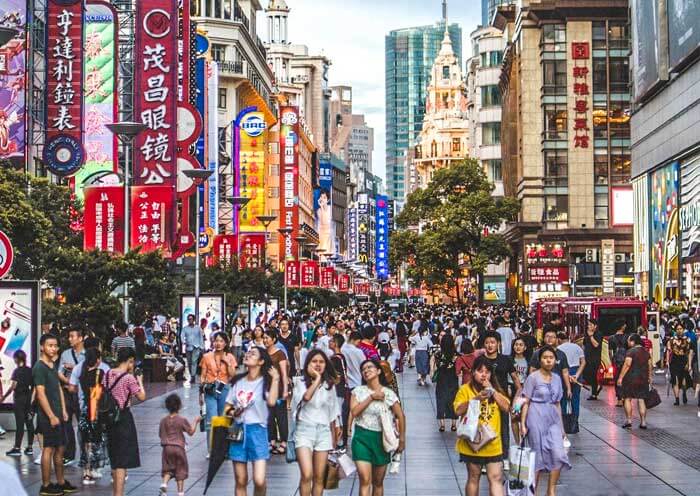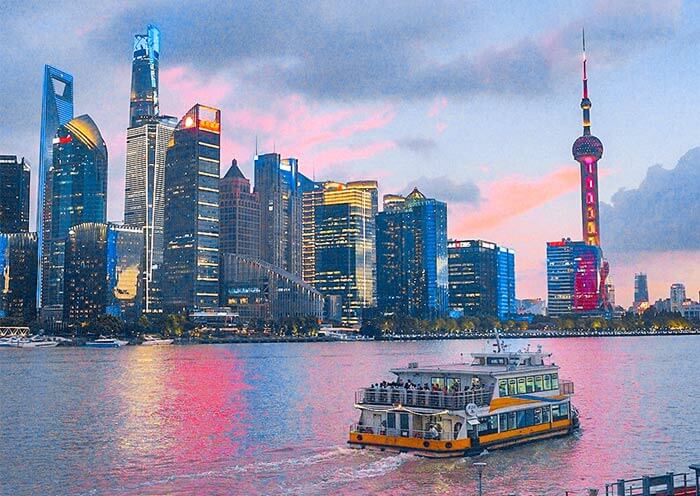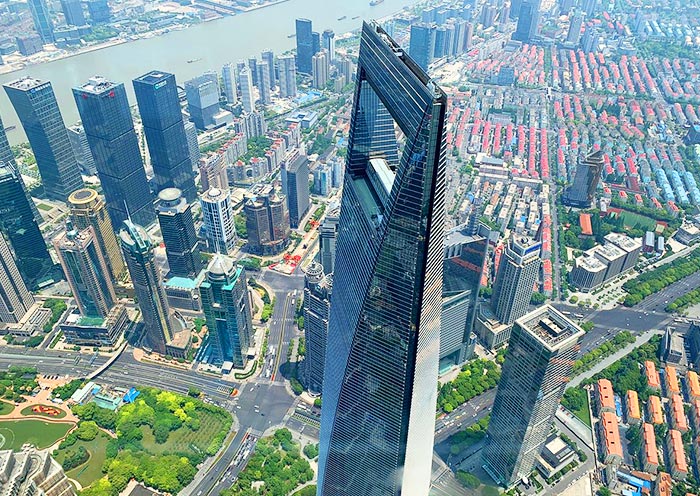Today you will spend the entire day exploring the Highlights of Shanghai from Shanghai Old Town to Shanghai Pu Dong New Area. You will experience the perfect blend of the East and West in this “Paris of the East” by visiting brilliant museums, traditional Chinese gardens, Taoist Temples, local snacks streets, modern skyscrapers, and exotic architecture.
First, head to the Shanghai Museum (上海博物馆Closed on Mondays) which is one of the four major museums in China, along with the Palace Museum, Shaanxi History Museum, and Nanjing Museum. It is built in the shape of an ancient bronze cooking vessel called a ding鼎, with a round top and a square base, symbolizing "Round Sky, Square Earth天圆地方". The museum houses a collection of 1.02 million cultural relics, including 144,000 precious artifacts and it is particularly notable for its bronze, ceramics, calligraphy, and painting pieces. Take your time to seek out the Top 10 treasures in the Shanghai Museum, such as the Dake Ding (大克鼎a bronze food vessel over 3,000 years old), the Chime Bells of Jinhousu (晋侯苏钟ancient musical instrument,1046 BC - 771 BC), the Shang Yang Fang Sheng (商鞅方升a square bronze capacity measure made by Shang Yang, 390 BC - 338 BC), and the Pastel Porcelain Bottle with Bat Peach Olive from the Qing Dynasty/Yongzheng Period (清雍正粉彩蝠桃纹橄榄瓶). Among them, there is a very interesting treasure you should not miss - the "Zizhongjiang Plate子仲姜盘", which is an exquisite bronze artifact. It was a precious gift given by Zizhongjiang to his beloved wife over 2,600 years ago. The Zizhongjiang Plate was used to collect waste water when washing hands in ancient times. After filling the plate with water, one can not only see the relief sculptures of aquatic creatures underwater but also observe fish, frogs, turtles, and water birds that rotate freely in the water. Each of these animals is mounted on a vertical axis that can rotate 360 degrees in place. You will marvel at the highly skilled craftsmanship of artisans from the Bronze Age and be touched by the love and romance between Zizhongjiang and his wife.
Next, move to Yu Garden (Closed on Mondays), the most celebrated classical Chinese garden hidden in the bustling downtown area of Shanghai, where you can appreciate the beauty of a Jiangnan water town (江南水乡)! Yu Garden (Yuyuan Garden豫园) was a private garden of the Ming Dynasty (1368-1644) with a history of over 460 years. Nowadays, as a must-visit destination in Shanghai, it has always been praised as "the Best of Famous Gardens in Southeast China". Yu Garden was built in 1559 by Pan Yunduan (潘允端) for his father to enjoy his retired life. The Chinese character "Yu豫" in Yu Garden means "safe平安," expressing his filial piety towards his parents. Pan Yunduan spent 20 years creating exquisite pavilions, shaded corridors, pools churning with carp, carved beams, and painted rafters in the garden. You will see the winding paths and changing scenery, the plants and ponds, the brick carvings, stone carvings, clay sculptures, and wood carvings in the garden, all designed with great craftsmanship. According to research, the garden designer of both Yu Garden and Daguanyuan Garden (the famous garden described in the "Dream of the Red Chamber", one of the Four Great Classical Novels of China) is likely to be the same person - Zhang Nanyang (张南阳), a garden master from the late Ming dynasty and a native of Shanghai. On the way to Yu Garden, you will pass by the iconic Jiuqu Bridge (九曲桥Nine-Bend Bridge/Zigzag Causeway) and the Huxin Pavilion (湖心亭Mid-lake Pavilion, built in the Qing Dynasty, 1616-1912). According to Chinese Fengshui, the zigzag causeway is designed to thwart spirits, who can only journey in straight lines. Known as the "First Teahouse on the Sea" (over 160 years old), the Huxin Pavilion is a perfect spot to enjoy a distant view of Shanghai's Lujiazui Skyline (陆家嘴三件套). As you enter Yu Garden, you can explore various beautifully crafted dragons hidden in the buildings, count them, and learn more about the Chinese dragon totem from your guide. In Yu Garden, you can admire numerous architectures from the Ming and Qing Dynasties, as well as the collections of ancient calligraphy, paintings, and furniture. Don't forget to seek out the 21-meter-tall ginkgo tree that is said to have been planted by Pan Yunduan himself. After the Yuyuan Garden Tour, you will understand why it even received visits from international dignitaries, including former Estonian President Meri, former Canadian Prime Minister Chrétien, former Luxembourg Prime Minister Juncker, and former Greek Prime Minister Simitis.
Then, you can move to Shanghai City God Temple (ChenghuangmiaoTemple城隍庙) located near Yu Garden. Chenghuangmiao (City God Temple), dating back to the Northern and Southern Dynasties (420-589), is a Taoist temple dedicated to the City God (Cheng Huang God). "Cheng城" refers to the city walls, while "Huang隍" refers to the dried-up moats. The City God is the protective deity of the city and is often a renowned hero or figure from local history. In ancient China, nearly all authentic cities had city walls and moats as military facilities to ensure urban safety. The Chenghuangmiao (城隍庙) in Shanghai was initially dedicated to General Huo Guang (霍光the brother of General Huo Qubing霍去病, a famous General well-known by Chinese people) from the Han Dynasty (202BC-220). During the Ming Dynasty (1403-1424), it was reconstructed as the City God Temple, and Huo Guang became the guardian deity of Shanghai. Within this temple, which has a history of over 600 years, the City God Qin Yubo (秦裕伯an imperial scholar of the Yuan Dynasty, 1271-1368) is also worshiped. He manages the affairs of both the mortal and spiritual realms and is assisted by two judges (黑白无常) who oversee human deeds, with the "white-faced" judge recording good deeds and the "black-faced" judge recording bad deeds. When people pass away, the City God settles their accounts. Those with more good deeds than bad deeds enter heaven, while those with more bad deeds than good deeds go to hell.
Strolling inside Chenghuangmiao, you will see a large abacus (算盘) that is quite intriguing. It bears the Chinese characters "not calculated by humans" (不由人算). Remember to ask your tour guide to explain the profound Chinese philosophy behind it. If you wish to meet your Mr. Right, make sure to visit the Temple of the Matchmaker (Yuelao Temple月老殿) and pay respects to the God of Love and Marriage (Chinese Cupid月老). Legend has it that the Yuelao (月老Matchmaker) ties an invisible red thread around the feet of destined couples, uniting them in love. If you desire wealth, visit the Temple of Wealth (财神殿) and pay homage to the God of Wealth (财神), Marshal Zhao Gongming (赵公明), who oversees fair trade and the distribution of wealth in the mortal realm. As a coastal city, Shanghai City God Temple also enshrines the Goddess Mazu (天后妈祖), who protects seafaring vessels. During festive occasions, Shanghai residents often visit the City God Temple for worship, making it an indispensable place for traditional ceremonies. With the increasing number of visitors, the surrounding commercial shops around the temple have also multiplied, forming an antique-style architectural complex centered around Yuyuan Bazaar, which has become the bustling pedestrian street in downtown Shanghai. As night falls, the entire street becomes even more resplendent.
However the phrase "go to Chenghuangmiao" used by Shanghai locals does not solely refer to the Taoist temple itself but rather encompasses the entire area of Yuyuan Bazaar. Yuyuan Bazaar (Chenghuangmiao Market) outside Yu Garden is a vibrant Shanghai Old Street where you can try Shanghai’s local snacks such as Xiaolongbao (Nanxiang Steamed Bun Restaurant小笼包), Pan-Fried Pork Buns (Fried Dumplings生煎包), Soup Dumplings (灌汤包), and Won-ton Soup (上海馄饨). You can also buy some traditional Chinese handicrafts and artworks for souvenirs here.
Hailed as the "Shanghai Version of Along the River During the Qingming Festival (上海版清明上河图)" , Yuyuan Bazaar (豫园商城) is originated from the Chenghuangmiao Market (城隍庙小吃街) over 140 years ago during the Qing Dynasty. Today, it has become a popular destination for Shanghai residents and visitors alike, offering opportunities for leisure, shopping, and experiencing the taste of Old Shanghai (老上海). It encompasses folk customs, elegance, and the unique local culture, encapsulating China as seen by foreigners, Shanghai as seen by Chinese people, and the hometown as seen by the locals. If you come during the Chinese New Year Holiday (Spring Festival), you can experience the Yu Garden Folk Lantern Festival (豫园灯会with a history of over 130 years), which has been recognized as a national intangible cultural heritage project since 2011. The festival has now become the liveliest spot for the Chinese New Year atmosphere in Shanghai, as well as for Shanghai people.
Notes:
1. Please note that both the Shanghai Museum and Yuyuan Garden are closed on Mondays. We are always flexible and want to ensure you with the best experience.
2. On Mondays, you can choose to visit the Shanghai Urban Planning Exhibition Hall (located near the Shanghai Museum, closed on Wednesdays) or the Shanghai Propaganda Poster Art Centre (approximately 5km away from the Shanghai Museum) instead.
3. On Mondays, you can choose to visit the Daoist City God Temple (located near Yuyuan Garden) instead of Yuyuan Garden.
4. Please feel free to contact our travel consultant in advance to discuss and make arrangements, as many museums and sites require advance ticket bookings. Thank you for your understanding.
After lunch, you can take a hike from Nanjing Road to the Bund, which is less than a 2 km walk. Typically, when mentioning Nanjing Road, it refers to strolling from Nanjing Road West to Nanjing Road East (about 1.1 km), and then continuing from Nanjing Road East to the Bund (about 0.6km).
Nanjing Road Pedestrian Street is one of the iconic attractions of Shanghai, known as the "Number One Commercial Street in China". It has a history of more than 170 years, dating back to 1848, and showcases various architectural styles including European, Chinese, and modern designs. It serves as a window to Shanghai's openness to the world and a paradise for shoppers from both domestic and international locations. Nanjing Road is the perfect place to experience century-old Chinese time-honored shops, such as Wuliangcai Optical (吴良材眼镜店), founded in 1806; Hope Brother's & Co (亨达利钟表店), established in 1874; Duoyunxuan (朵云轩), the most famous calligraphy and painting store in Shanghai, founded in 1900; and Wang Kai Photograph(王开照相馆), the largest deluxe photography studio in Shanghai since 1923. You can also visit Shanghai Shimao Festival City (上海世茂广场) and explore the first flagship LEGO store in Asia, the flagship Nike store, and the exclusive flagship store of MM Chocolate in Asia. If you're interested, you can experience the famous curved escalator at the New World Daimaru Department Store (新世纪大丸百货), explore the Huawei Global Flagship Store (华为旗舰店), enjoy afternoon tea on the rooftop terrace of Shanghai Edition Hotel (上海艾迪逊酒店) while overlooking the Bund, and marvel at the century-old Gothic architecture of the Peace Hotel (和平饭店), where Einstein and Chaplin once stayed. At the Peace Hotel, you can capture a photo of the Oriental Pearl TV Tower standing in the middle of the street alley. Nanjing Road is also a paradise for food lovers, so don't miss a visit to Shanghai's first food store and Shen Dacheng Dim Sum Shop.
Walking from Nanjing Road East to the Bund, you will have the feeling of traveling back to the 1930s and 1940s. As the Top 1 Place to Visit on the Shanghai Bucket List, the Bund is the best spot to view the Oriental Pearl TV Tower (a symbol of Shanghai) and the three skyscrapers of Lujiazui that are famed as the "Kitchen Three Piece Set" (陆家嘴三件套) by locals due to their shapes: a syringe (Jin Mao Tower, 421m), bottle opener (Shanghai World Financial Center, 493m), and eggbeater (Shanghai Tower, 546m), respectively. Located on the bank of the Huangpu River and renowned as “An Exhibition of International Buildings”, the Bund is a collection of 52 buildings representing various international architectural styles. Since 1844 (Qing Dynasty), foreign banks, trading companies, clubs, and newspapers have gathered here, showcasing the former glory of the "Wall Street of the Far East" (远东华尔街).
You can hike in the core section of the Bund which stretches about 1.5 km from Waibaidu Bridge (外白渡桥) in the north to Jinling East Road (金陵东路) in the south, along Zhongshan East First Road (中山东一路), with Peace Hotel (near Nanjing East Road) in the middle. Starting from Nanjing East Road, you can begin your exploration by enjoying a cup of coffee on the Most Beautiful Balcony of Shanghai (上海最美露台) at the Somekh Building (沙美大楼) and catching a glimpse of the Peninsula Shanghai Hotel (上海半岛酒店) and Bund Source 33 (外滩源33) along the picturesque pathway of Yuanmingyuan Road (圆明园路). You will visit the Zhapu Road Bridge (乍浦路桥) to capture the "Shanghai Version of Seine River Scenery"(上海版塞纳河风光), followed by Waibaidu Bridge (外白渡桥Garden Bridge of Shanghai), where you can admire the Russian Consulate building (俄罗斯领事馆green roof) that combines Baroque and German Renaissance styles. At Huangpu Park (黄埔公园), established in 1886, you can pay tribute to the Monument to the People's Heroes (人民英雄纪念塔) and discover more about the history of the Bund. After passing the Peace Hotel, you won't miss the iconic Clock Tower at the Shanghai Customs House (江海关大楼), the HSBC Building (汇丰银行), the Golden Bull Plaza (金牛广场sculpture of a golden bull), and the Gutzlaff Signal Tower (外滩天文台), all of which are classic attractions of the Bund.
After the Bund tour, you will reach Jinling East Road to board a public ferry to cross the Huangpu River, transferring you from Old Shanghai Town to Lujiazui Financial District in Shanghai Pudong New Area. The Huangpu River is a man-made river that flows north through Shanghai and serves as the last significant tributary of the Yangtze before the Yangtze empties into the East China Sea. The Huangpu River Ferry Ride takes about 10 minutes, departing from Jinling East Road Pier (金陵东路渡口) and arriving at Dongchang Road Pier (东昌路渡口路). Since the ferry operates every 15 minutes in the afternoon, including the queuing time, it will take about 40 to 60 minutes to experience the Shanghai Public Ferry (2 yuan per person上海轮渡) like a local and enjoy the splendid views along Shanghai's Mother River. (Notes: The ferry is a regular means of transportation rather than a tourist sightseeing boat or cruise, so it is rather simple and lacks seating. The best view can be enjoyed from the second deck, but it may be crowded, so be sure to secure a favorable position and prioritize safety.)
After the Huangpu River Ferry Ride (黄浦江), you will take a walk to the highest building in Shanghai - the Shanghai Tower. It features a dramatic 120-degree twist from its base to its peak. Take the world's fastest lifts (traveling at 64km/h) to the "Top of Shanghai Observatory" located on the 118th floor, 546 meters above ground level. Here, you'll have the unparalleled opportunity to enjoy a 360-degree panoramic view of modern Shanghai and also look down upon the Oriental Pearl TV Tower (a cultural landmark of Shanghai), Jin Mao Tower (a traditional Chinese pagoda-like structure with a modern style) and the Shanghai World Financial Center (the third tallest building in China and the fifth tallest in the world). From Shanghai Tower, you can also get a bird's eye view of the Bund and the Nanjing Road you had just visited before from another side of the Huangpu River.
After visiting the Shanghai Tower, it is time to conclude today's tour. By the way, the lights on the Bund turn on at 19:00 and turn off at 22:00. In the evening, the neon lights on both sides of the Huangpu River create a stunning display, making it perfect for experiencing the charm of the so-called "Magical City" (Shanghai), known as the "City That Never Sleeps". If you would like, you can choose to participate in additional Shanghai evening tours according to your schedule. Feel free to contact us in advance to book your evening tour with us.
Options for the Shanghai Evening Tour:
1. Xintiandi Night Tour
Xintiandi (新天地) is a bustling place that seamlessly blends Shikumen architecture (石库门) with modern urban fashion style. It offers a comprehensive introduction to the local Shikumen (stone-gate house) architecture, along with enticing dining and shopping options. This upscale entertainment and shopping complex is modeled on traditional “Nong Tang” (弄堂alleyway) homes and stands as the pioneering development in the city, demonstrating the commercial viability of preserving historical architecture.
2. Shanghai Acrabat Evening Show (19:30- 21:00, 1.5 hours)The Shanghai Acrobatic Show is a beloved and enchanting evening delight for tourists visiting Shanghai. This captivating spectacle is brought to life by the renowned Shanghai Acrobatic Troupe, a troupe that has graced stages since its establishment in 1951. With their international acclaim, the troupe regularly presents their mesmerizing performances not only in Shanghai but also in various cities across China. Prepare to be amazed as the show unfolds with a breathtaking blend of acrobatics, graceful dance, rib-tickling comedy, mystifying magic, and awe-inspiring displays of aerial strength. Through this extraordinary showcase, the essence of Shanghai's rich cultural heritage is beautifully honored, transporting you to a world of wonder and marvel.
Then, it is time to end your 1-day Classic Shanghai Tour. Your guide will escort you to your hotel. Or head to the airport/train station for your flight or high speed train to your next destination.
Thank you for choosing Asia Odyssey Travel for your China tour, and we are always here working for you and hope to see you again for your next trip around China and Asia. Safe journey!


